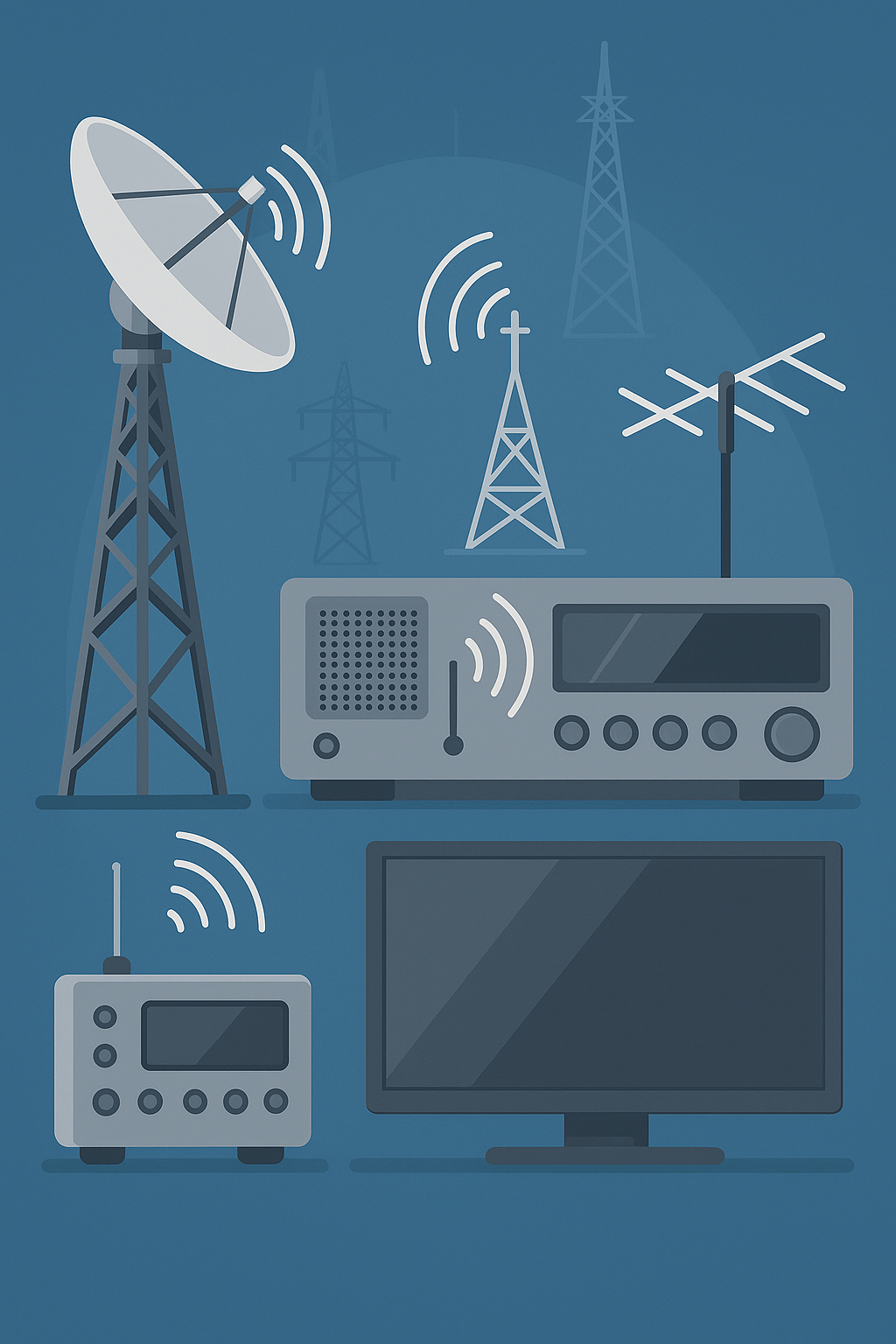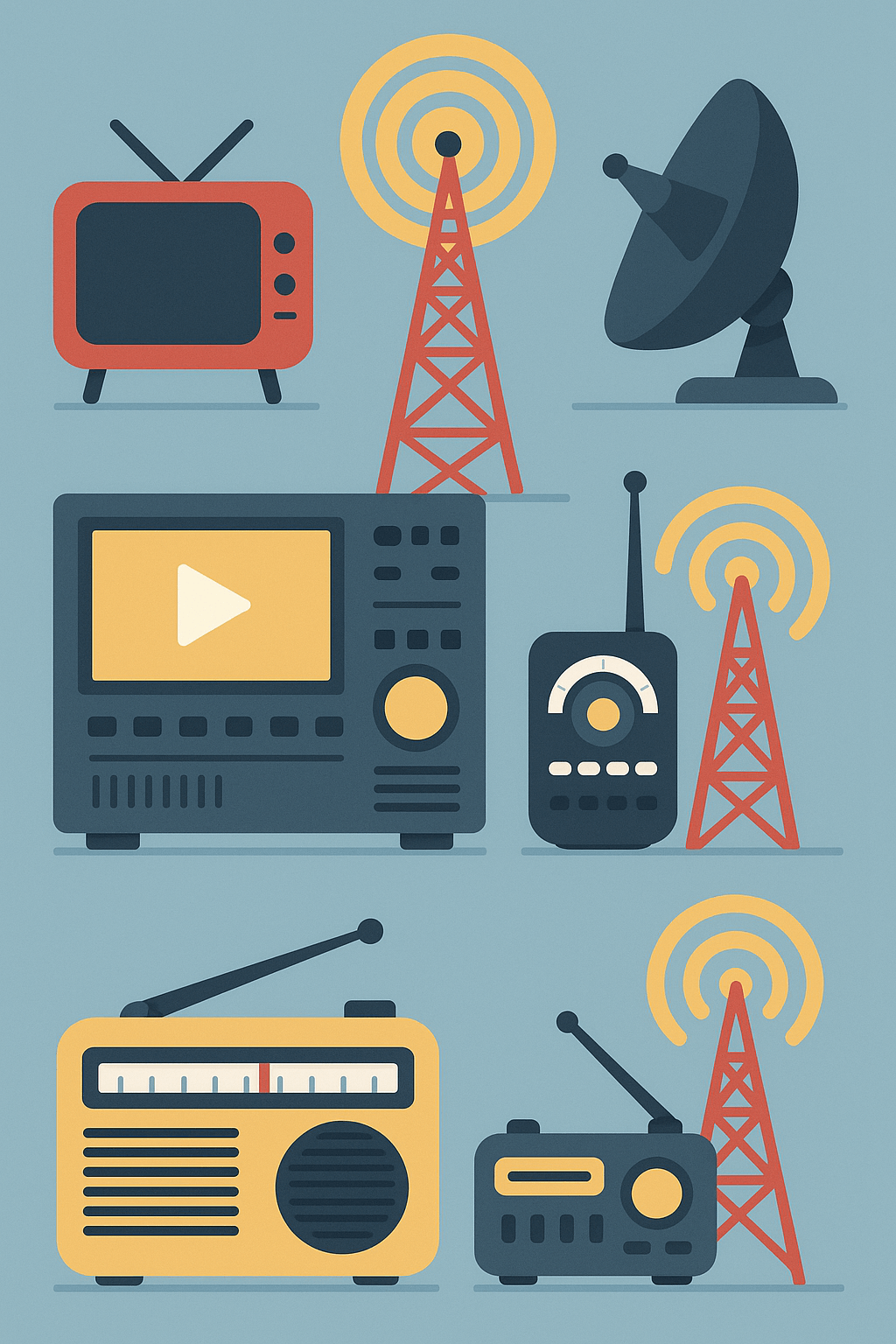Customs Clearance of Various Transmitter and Receiver Devices for Radio and Television (HS Code + Documents and Licenses)
Radio and television transmitter and receiver devices are recognized as vital components in modern communication and media systems. These devices include a wide range of advanced equipment used to transmit and receive audio and video signals. Among the most important of these are radio transmitters, television transmitters, digital receivers, telecommunication antennas, and amplifiers. The role of these devices in establishing and maintaining broadcast and telecommunication networks is highly significant, as without them, widespread and high-quality broadcasting of television and radio programs would not be possible.

For estimating the time and cost of clearing broadcasting, transmitter, and receiver equipment, contact the experts at Saba Tarkhis.
Immediate Free Consultation1) Detailed Description of Broadcasting and Telecommunication Equipment
This group includes radio/TV transmitters, modulators, digital receivers (Set-Top Boxes/IRDs), power amplifiers, antennas, and accessories. Due to their RF nature and effect on the frequency spectrum, these goods are subject to technical controls and require special licenses. Accurate tariff classification, firmware version, frequency band, output power, DVB/ATSC/ISDB standards, and interference requirements are the key to fast customs clearance.
2) Key Applications of Transmitter and Receiver Devices
- Television Broadcasting: Television transmitters are used to send video and audio signals from broadcasting stations to television receivers in homes and other locations. This process involves converting digital signals into radio waves, which are then received by receivers and transferred to displays.
Radio Broadcasting: In radio broadcasting systems, radio transmitters are responsible for sending audio signals. These signals, after being processed and amplified in the transmitters, are converted into radio waves and transmitted through broadcasting stations to radio receivers, allowing audiences to listen to radio programs.
Telecommunication Networks: In the telecommunications sector, these devices are used for transmitting data, voice, and video between mobile networks and satellite communication systems. Their importance in enabling wireless communications and high-speed data transfer is remarkable.
Security Systems: In many video surveillance and security systems, transmitters and receivers are used to transfer surveillance images and data. These systems are commonly applied in public places, government organizations, and sensitive industries.
Marine and Aviation Communications: In marine and aviation transportation industries, these devices play a key role in enabling wireless communication between ships, aircraft, and ground stations. These communications are essential to ensure safety and coordinate critical operations.
3) Important Points in Transmitter/Receiver Clearance
- Necessary Licenses: Importing these devices requires special permits from relevant organizations such as the Communications Regulatory Authority (CRA). These licenses ensure that imported devices comply with national and international standards and do not cause interference with existing telecommunication and broadcasting networks. Failure to obtain these permits can result in clearance delays or even return of goods from customs.
Quality Standards and Authenticity: Checking the authenticity and quality of imported devices is highly important. Telecommunication equipment must be designed and manufactured according to international standards. Non-standard or counterfeit equipment may cause serious technical issues and even lead to complete broadcasting shutdown. Therefore, all certificates and quality documents must be verified before import.
Environmental Regulations: Some transmitters and receivers may contain hazardous substances such as lead and other heavy metals. These substances must be managed according to environmental regulations. Importers should ensure that the devices comply with environmental standards of the destination country and, if necessary, provide documents regarding proper handling of hazardous materials.
For radio and television transmitters and receivers, HS Code 852510 refers to radio and television transmitters, including advanced equipment designed for broadcasting TV and radio signals. This code covers television transmitters with different power levels and technologies (analog and digital).
HS Code 852580 refers to digital receivers and similar equipment such as set-top boxes. This code includes advanced equipment designed to receive and process digital signals from broadcasting stations or satellite networks.
The customs tariff for these devices, depending on their type and technology, usually ranges between 5% and 20%. Tariffs are determined based on the value of the device and its classification under the HS code. Some of these devices may qualify for special tariffs or exemptions under specific conditions.
4) HS Code and Customs Tariff
| Goods Group | Short Description | HS Code |
|---|---|---|
| Radio/TV Transmitters | Transmitters with different power/bands, analog/digital | 852510 |
| Digital Receivers and Similar Equipment | Set-Top Box/IRD and digital signal processing equipment | 852580 |
The usual tariff for this group, depending on technology/application, ranges around 5% to 20%; final determination is made after valuation and review of technical documents.
5) Special Import and Export Conditions
Due to their telecommunication nature, the import of these devices is under the scrutiny of regulatory/security authorities. Obtaining CRA permits, complying with frequency requirements, accurate order registration, and firmware updates according to the destination country are prerequisites. Some items may fall under international restrictions; pre-inquiry before purchase is recommended. Export from Iran is limited but possible for regional projects (Iraq/Afghanistan).
6) Iranian Market: Exporting Countries and Limited Export Destinations
- Most radio and television transmitter and receiver devices imported into Iran are supplied from industrial and advanced countries. These include:
China: As the largest producer of telecommunication equipment in the world, China plays a major role in supplying Iran’s demand for transmitter and receiver devices.
Germany: With high-quality and advanced technology devices, Germany is one of the main sources of Iran’s telecommunication equipment imports.
South Korea and Japan: These two Asian countries, as producers of telecommunication equipment with modern technologies, hold a significant share in Iran’s market.
United States: Although imports from the US are restricted due to sanctions, advanced telecommunication equipment from this country is imported into Iran. - Iran is mostly recognized as an importer of these devices, and their export to other countries is limited. However, countries like Iraq and Afghanistan, which require affordable telecommunication equipment, are among Iran’s limited export destinations.
7) Iran’s Import/Export Volume
The import volume of these devices into Iran has increased in recent years due to the growing need for telecommunication and digital infrastructure development. This increase is especially evident in the field of digital and advanced equipment, driven by the transition toward digitalizing TV and radio broadcasting systems. On the other hand, exports from Iran are very limited due to production and technology restrictions.
8) Global Market and Technology Trends
The global market for radio and television transmitters and receivers is growing due to advances in communication technologies and the development of digital networks. Asian countries such as China and South Korea are recognized as major producers of this equipment, while European and North American countries are the main consumers. The global trade volume in this industry reaches billions of dollars annually, and it is predicted that with the advancement of new technologies like 5G and the development of the Internet of Things (IoT), this volume will increase in the future.

Frequently Asked Questions
What is the HS Code for broadcasting equipment?
Radio/TV transmitters are declared under 852510 and digital receivers/set-top boxes under 852580.
What license is required for import?
A permit from the Communications Regulatory Authority (CRA) for spectrum/power and non-interference + technical certificates (CE/FCC/IEC).
What is the import tariff for this equipment?
Depending on technology and value, usually around 5% to 20%; exact determination is made after customs valuation.
Special Customs Clearance Services by Saba Brokerage
With years of experience in customs clearance across Iran, we offer specialized services for clearing radio and TV transmitter and receiver devices. These services include:
Obtaining Licenses: With our expert team, we quickly and accurately obtain all necessary permits from organizations such as the CRA, ensuring full legal compliance for importing this equipment.
Expert Consultation: By providing professional advice on importing and clearing telecommunication devices, we help you make the best decisions. Our consulting is based on in-depth knowledge of the market and customs regulations.
Continuous Follow-up: One of our key features is ongoing and precise monitoring of all clearance stages. From the moment the goods enter customs to final delivery, every step is tracked, and in case of any issues, immediate action is taken.
Cost Management: Given the complexity of customs tariffs, we help you minimize import and clearance costs. Through accurate tariff analysis and applying the best strategies, we prevent unnecessary expenses.
Speed and Accuracy Guarantee: By using an extensive network of customs experts and partners, we guarantee fast and accurate clearance. Our goal is to deliver your goods as quickly as possible without any delays in the process.
With these services, you can manage the import and clearance process of radio and TV transmitter and receiver devices with full confidence and professionalism. Our aim is to help you achieve your business goals without worrying about customs complexities.
Contact us now for more information and expert consultation.
.png)
